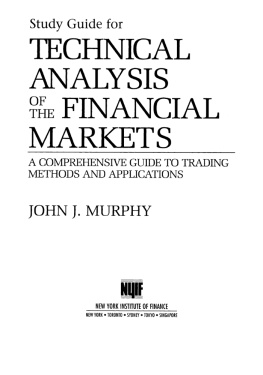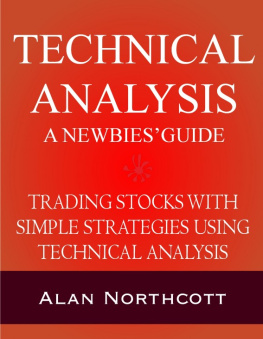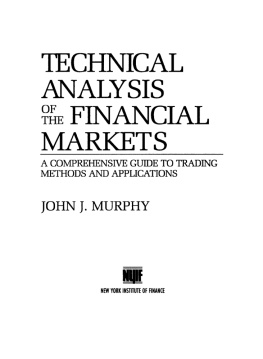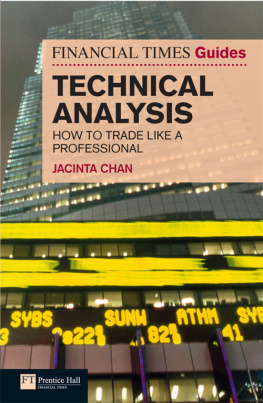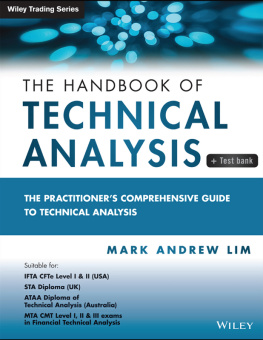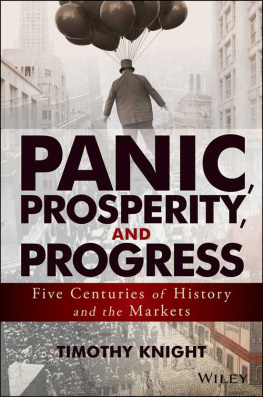John J. Murphy - Study Guide to Technical Analysis of the Financial Markets
Here you can read online John J. Murphy - Study Guide to Technical Analysis of the Financial Markets full text of the book (entire story) in english for free. Download pdf and epub, get meaning, cover and reviews about this ebook. year: 1999, publisher: Penguin Publishing Group, genre: Home and family. Description of the work, (preface) as well as reviews are available. Best literature library LitArk.com created for fans of good reading and offers a wide selection of genres:
Romance novel
Science fiction
Adventure
Detective
Science
History
Home and family
Prose
Art
Politics
Computer
Non-fiction
Religion
Business
Children
Humor
Choose a favorite category and find really read worthwhile books. Enjoy immersion in the world of imagination, feel the emotions of the characters or learn something new for yourself, make an fascinating discovery.
- Book:Study Guide to Technical Analysis of the Financial Markets
- Author:
- Publisher:Penguin Publishing Group
- Genre:
- Year:1999
- Rating:4 / 5
- Favourites:Add to favourites
- Your mark:
- 80
- 1
- 2
- 3
- 4
- 5
Study Guide to Technical Analysis of the Financial Markets: summary, description and annotation
We offer to read an annotation, description, summary or preface (depends on what the author of the book "Study Guide to Technical Analysis of the Financial Markets" wrote himself). If you haven't found the necessary information about the book — write in the comments, we will try to find it.
Study Guide to Technical Analysis of the Financial Markets — read online for free the complete book (whole text) full work
Below is the text of the book, divided by pages. System saving the place of the last page read, allows you to conveniently read the book "Study Guide to Technical Analysis of the Financial Markets" online for free, without having to search again every time where you left off. Put a bookmark, and you can go to the page where you finished reading at any time.
Font size:
Interval:
Bookmark:

TECHNICAL ANALYSIS
OF THE
FINANCIAL MARKETS Study Guide for TECHNICAL ANALYSIS
 FINANCIAL MARKETS A COMPREHENSIVE GUIDE TO TRADING
FINANCIAL MARKETS A COMPREHENSIVE GUIDE TO TRADINGMETHODS AND APPLICATIONS JOHN J. MURPHY

 | NYIF NEW YORK INSTITUTE OF FINANCE NYIF and NEW YORK INSTITUTE OF FINANCE are trademarks of Executive Tax Reports, Inc., used under license by Penguin Putnam Inc. |
Analysis of the Futures Markets (NYIF, 1987).
All rights reserved. No part of this book may be reproduced
in any form or by any means,
without permission in writing from the publisher. Portions of this book were previously published as
Technical Analysis of the Futures Markets (New York Institute
of Finance, 1985). ISBN: 978-1-101-65920-5 Most NYIF books are available at special quantity discounts for bulk purchases for sales promotions, premiums, fund-raising, or educational use. Special books, or book excerpts, can also be created to fit specific needs. For details, write: Special Markets, Penguin Putnam Inc., 375 Hudson Street, New York, New York 10014.
 This self-study manual has been designed and prepared by the New York Institute of Finance, with the cooperation and input of John J.
This self-study manual has been designed and prepared by the New York Institute of Finance, with the cooperation and input of John J.Murphy. This workbook is to be used exclusively with John J. Murphys Technical Analysis of the Financial Markets (referred to as the text). The workbooks objective is to testand thereby to ensureyour comprehension of the large body of knowledge associated with technical analysis. The methodology is simple to follow and uses your time efficiently. Here are the recommended steps: Before reading the textbook, go to Lesson One in the Study Guide (page 1). There you will find the Reading Assignment, which for the first lesson is of the text.
You will also find a set of reading Objectives and a Reading Orientation, which give your reading focus and direction. Also note the list of Key Terms (page 2). Following each term is a page reference indicating where in the text you can find a definition or explanation of the term. Pay special attention to these terms. Read the chapters assigned for the lesson. As you read, stay aware of the objectives and key terms.
Ask questions of the text. Dont be afraid to underline what you feel is importantor make marginal notes. Go to the Challenge section of the lesson (starting on page 3). There you will find a Matching Quiz, Multiple Choice, and sometimes Fill-In questions. Answer the questions closed book as best you can. Turn to the Answer Sheet, and compare your answers against those given there.
To grade yourself on these exams, divide the number of correct answers by the total number of answers and multiply the answer by 100. The result is your percentage right. Should your grade be lower than 65%, you should re-read the material for that lesson. The purpose of this comparison, however, is not to give yourself a grade. Rather, it is to determine the areas where your comprehension is weak. Toward that end, each answer has a page reference to the text and a brief explanation of why the answer is correct.
We suggest that you follow up these page references by re-reading the relevant sections of the text and making sure you understand the answer. Once you have taken these steps for , beginning on page 7. This workbook has been produced with the utmost concern for accuracy and freedom from error. Nevertheless, we welcome your comments with regard to improvement. New York Institute of Finance
Publishing Division
and the Dow Theory
 READING ASSIGNMENT of the text. OBJECTIVES After completing this lesson, you should be able to: Define the basic terms, concepts, and premises of technical analysis.
READING ASSIGNMENT of the text. OBJECTIVES After completing this lesson, you should be able to: Define the basic terms, concepts, and premises of technical analysis. Distinguish fundamental from technical analysis. Compare and contrast the Random Walk and Dow Theories. READING ORIENTATION deal largely with the basis and background of technical analysis. As you progress in the course, you will see again and again the terms and concepts that are introduced in these chapters. For now, a general understanding of the basic terms is adequate. Before reading the assignment, review the key terms on the next page.
Look for them as you read. When youve completed your reading, go to page 3. KEY TERMS accumulation, 26 chartist, 1012 confirmation, 27 correction, 26 day trading, 9 descriptive statistics, 18 distribution, 26 divergence, 27 Dow Theory, 27, 31, 3233 efficient market hypothesis, 1921 failure swing, 2931 flow of fund analysis, 15 fundamental forecasting, 56 inductive statistics, 18 lines, 31 market action, 12 minor trend, 2526 price action, 2 primary trend, 2526 public participation, 26 Random Walk Theory, 1921 secondary trend, 26 sentiment indicators, 15 statistical (quantitative) analyst, 11 technical forecasting, 56 technician, 1012 timing, 67 traditional chartist, 1012 trends, 2530 trend trading, 10 volume, 27 CHALLENGE MATCHING QUIZ Match each term at the left with a definition at the right, by placing the number of the definition in the fill-in space next to the term. A definition may be used more than once. There are more definitions than terms.
| A. accumulation | 1. accumulation | 1. Either the industrial or the Rail average gives the signal, not both. |
| B. _____ chartist | 2. Usually retraces 33% to 50%. | |
| C. _____ confirmation | 3. Trading intraday changes, tic by tic. | |
| D. _____ correction | 4. A reversal pattern. | |
| E. _____ day trading | 5. Price, volume, open interest. | |
| F. _____ descriptive statistics | 6. Study of the effect of supply and demand on commodity prices. | |
| G. _____ distribution | 7. The Industrial and Rail averages give the signal. | |
| H. _____ divergence | 8. Informed buying by astute investors. | |
| I. _____ Dow Theory | 9. A secondary indicator that should expand in the direction of the trend. |
Font size:
Interval:
Bookmark:
Similar books «Study Guide to Technical Analysis of the Financial Markets»
Look at similar books to Study Guide to Technical Analysis of the Financial Markets. We have selected literature similar in name and meaning in the hope of providing readers with more options to find new, interesting, not yet read works.
Discussion, reviews of the book Study Guide to Technical Analysis of the Financial Markets and just readers' own opinions. Leave your comments, write what you think about the work, its meaning or the main characters. Specify what exactly you liked and what you didn't like, and why you think so.

